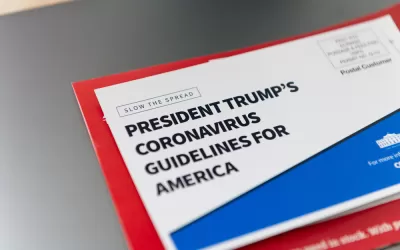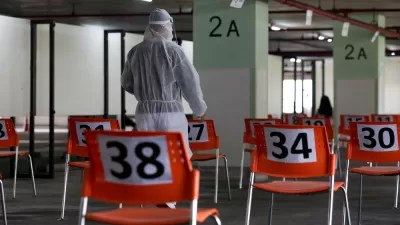Research from Columbia University Mailman School of Public Health looks at the timing of the imposition of public health control measures, at the start of the pandemic and in the present if infections increase, to project lives saved or lost.

At a White House Coronavirus Task Force press briefing on March 16, President Trump announced "new guidelines for every American to follow over the next 15 days as we combat the virus" and released a two-page advisory document, "The President's Coronavirus Guidelines for America [pdf]" that served as a signal to governors and state and county health officers that they needed to take action to keep their residents safe if they hadn't already done so.
A week later, after 535 Americans had succumbed to COVID-19, the U.S. surgeon general announced during the task force meeting, "I want America to understand this week it's going to get bad." And it did, particularly in places like New York, New Jersey and New Orleans.
As of May 23, the U.S. leads the world in coronavirus cases and deaths, with almost 1.7 million cases and over 98,000 deaths compared with over 5.4 million global cases and nearly 344,000 global deaths. Just over 1,000 Americans died of COVID-19 on May 22.
"If the United States had begun imposing social distancing measures one week earlier than it did in March, about 36,000 fewer people would have died in the coronavirus outbreak, according to new estimates from Columbia University disease modeler," write James Glanz and
Pandemic not under control
In response to a question by MSNBC host Rachel Maddow on May 21 to help visualize the "quantitative difference" that acting just a few days earlier makes, Shaman, who directs the Climate and Health Program, uses the example of an invasive lily in a pond.
"When you're dealing with the growth of a virus in a fully susceptible population, it's going through a doubling process – it's growing exponentially...They seem to start very small and insignificant...One of my favorite [examples] is an invasive lily in a pond and every day the number of lilies doubles. By day 30, the entire pond is covered in lilies. The question is, 'on what day was it half-way covered?'
"The answer, day 29, just the day before, because it is a doubling process."
Shaman warns against complacency as we move into summer because the virus may be seasonal and less transmissible during summer. He emphasizes the importance of keeping the infection rate, the number of new cases daily, low, until a vaccine and/or effective therapeutics are developed.
Sen Pei and Sasikiran Kandula, both research scientists at Columbia Mailman School of Public Health, are co-authors of the research which is awaiting peer review.
-
White House Could End 'Slow the Spread' Coronavirus Guidelines, March 24, 2020
FULL STORY: Lockdown Delays Cost at Least 36,000 Lives, Data Show

Study: Maui’s Plan to Convert Vacation Rentals to Long-Term Housing Could Cause Nearly $1 Billion Economic Loss
The plan would reduce visitor accommodation by 25,% resulting in 1,900 jobs lost.

North Texas Transit Leaders Tout Benefits of TOD for Growing Region
At a summit focused on transit-oriented development, policymakers discussed how North Texas’ expanded light rail system can serve as a tool for economic growth.

Why Should We Subsidize Public Transportation?
Many public transit agencies face financial stress due to rising costs, declining fare revenue, and declining subsidies. Transit advocates must provide a strong business case for increasing public transit funding.

How to Make US Trains Faster
Changes to boarding platforms and a switch to electric trains could improve U.S. passenger rail service without the added cost of high-speed rail.

Columbia’s Revitalized ‘Loop’ Is a Hub for Local Entrepreneurs
A focus on small businesses is helping a commercial corridor in Columbia, Missouri thrive.

Invasive Insect Threatens Minnesota’s Ash Forests
The Emerald Ash Borer is a rapidly spreading invasive pest threatening Minnesota’s ash trees, and homeowners are encouraged to plant diverse replacement species, avoid moving ash firewood, and monitor for signs of infestation.
Urban Design for Planners 1: Software Tools
This six-course series explores essential urban design concepts using open source software and equips planners with the tools they need to participate fully in the urban design process.
Planning for Universal Design
Learn the tools for implementing Universal Design in planning regulations.
Ascent Environmental
Borough of Carlisle
Institute for Housing and Urban Development Studies (IHS)
City of Grandview
Harvard GSD Executive Education
Toledo-Lucas County Plan Commissions
Salt Lake City
NYU Wagner Graduate School of Public Service





























